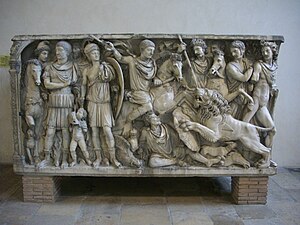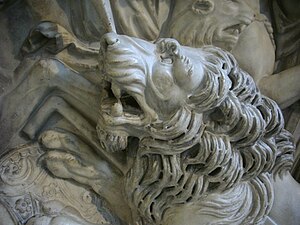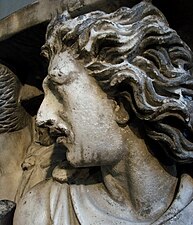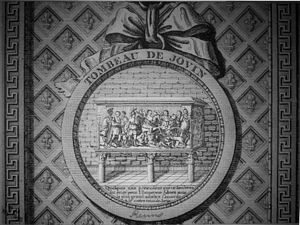Jovinus (consul)
Jovinus | |
|---|---|
 Portrait assumed to be of Jovinus, on his sarcophagus Reims, musée Saint-Remi. |
Flavius Jovinus (c. 310 - 370 AD) was a Roman general and consul of the Western Roman Empire. He was of Gallic or Germanic origin and was both born and buried in Durocortorum, modern day Reims.[1]
Jovinus spent his military career in Gaul, first appearing in the historical record as
Biography
Jovinus served as magister equitum in
After converting to Christianity, Jovinus sponsored the construction of the church of Saint-Agricole and Saint-Vital on the site of the present abbey church of Saint-Nicaise de Reims. He was buried in this church in 370 in a white Marmara marble sarcophagus imported from Italy. This sarcophagus measures 1.48m x 2.85m x 1.33m and weighs approximately 2 metric tons. On its front is a relief of a hunting scene, with Jovinus shown on horseback, spearing a lion. It has been in the Musée d'Archéologie de Saint-Rémi in Reims since 1958. However, its attribution to Jovinus has been disputed since 1880.[citation needed]
Jovinus is also credited with the founding of Joigny (Joviniacum) and Joinville.
- Sarcophagus of Jovinus, Reims, musée Saint-Remi.
-
View of the whole sarcophagus.
-
Detail of a lion.
-
Detail of one of the horsemen.
-
The tomb of Jovinus as it was presented in the old church of Saint-Nicaise in Reims, gravure (1878), Reims, Carnegie library (Reims)
See also
References
- ^ Jean-Yves Sureau, Les Rues de Reims, mémoire de la ville, Reims, 2002.
- ^ Ammianus Marcellinus, Res gestae, XXI 8,3
- ^ Ammianus Marcellinus, Res gestae, XXV 8,11
- ^ Biographie universelle ou dictionnaire historique. Vol. 3. Paris: Furne. 1833..
- ^ Ammianus Marcellinus, Res gestae, XXVII 2
- ISBN 1-55540-099-X.
- ISBN 0-521-07233-6.




